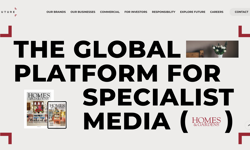Ask any publisher working with a B2B controlled circulation title to list the top five objectives for the forthcoming fiscal year, and you can rest assured, increasing the size of the print / online readership will feature near the top. Invariably, the rationale for wanting greater reader numbers will be revenue driven; a sales manager’s common cry is, "if we have more readers, I can sell more advertising". This makes sense - your advertisers want to invest their marketing budget in journals and magazines with a growing market share, because the more pairs of eyes focused on your title and their adverts, the better.
So how is this key objective of identifying and signing up more readers to be achieved? A publisher will have experience of varying subscriptions building techniques, from the more expensive outbound telemarketing initiatives through to traditional email and postal campaigns. For most of us, our subscriptions marketing plan for the forthcoming year will involve an array of planned activities aimed at keeping our readership numbers at or just above an agreed level. But, in reality, it is likely each activity will drip-feed in new subscribers rather than deliver them in huge gushing waves as we would like. Often the number of new readers obtained each month only just offsets those lost through the natural churn of the existing database and lapsed renewals, leaving the overall circulation figure fairly static.
Assuming we don’t have an unlimited subscriptions marketing budget (who does?), it is incumbent upon us as circulation professionals to use our existing resources to maximum effect, and to come up with increasingly inventive ways of bringing in new clusters of core readers that, providing we get the editorial content right, will remain loyal to us for years to come. This is often easier said than done. Not only is subscriptions marketing an art form in its own right, but finding new approaches to gaining readers can appear a near impossible task. What action can we take when our marketing budget is all but spent and the readership figures are still below that of a nearest competitor, for example? Let me offer you one idea that has worked well for Wiley-Blackwell, as I hope it will inspire you to find alternative ways to gain those all-important extra readers.
Out and about
When you look at your circulation team, what do you see? If you see a team of creative and perhaps technically focused individuals working hard to keep your circulation database up to date from behind their desks, then you’re probably seeing what ninety percent plus of publishing companies see too. With the exception of the odd trade show perhaps two or three times per year and a trip to the fulfilment house, circulation professionals are most commonly found working hard at their desks, as it’s what we do. Correction, it’s what we used to do. No longer can we afford to just sit in the office making phone call after phone call trying to convert a lead into a subscription, or sending out mailing after mailing. Our audience has hardened to many of these more traditional marketing methods and often our efforts are blocked well before ever reaching the intended recipient, a frustrating reality for many of us. We need a new approach, or more accurately put, perhaps we need to turn the clock back and return to a way in which lasting business relationships have been built for centuries; through face-to-face meetings with partners you can trust. This demands that your circulation team get out from behind their desks (scary I know) and become the living, breathing interface between your publication and its audience.
Declining reader base
When Wiley-Blackwell reviewed one of its monthly pharmaceutical titles in 2006, it was shown to have a steadily declining readership base. Whilst every effort had been made to plug the holes through many of the marketing methods already mentioned, the number of readers continued to erode. We knew, through feedback from our surveys, that the title was striking the right note editorially but despite our best efforts, we were failing to extend its reach into the market. Data mining techniques told us that many of the institutions currently receiving this title had vast swathes of industry professionals, all of which fitted the readership profile, but who were not subscribing to the journal despite considerable efforts to reach them. The challenge to the circulation team was to understand why this was happening and to reverse this downward trend in readership numbers. In real terms, we had to get out in the field and start asking questions face-to-face. In doing this we hoped to ascertain why our title wasn’t enjoying the success we were certain it deserved.
Acclimatisation
In deciding to send members of the circulation team out into the field, we first had to be sure they could cope with the change in environment – after all it is very different sitting in the comfort of the office making telephone calls to meeting your readers face-to-face. So before we did this we took the decision to send the chosen members of the team on client meetings with their colleagues in the sales team; this way they were able to become comfortable with offsite meetings and, most importantly, to enhance their listening and negotiation techniques. Both are skills integral to anyone planning to meet clients on a one-to-one basis.
Key accounts
In planning this approach, I decided to borrow from my own sales background and divide our readership into what we considered to be the main targets or ‘key accounts’, and set about a series of meetings with the primary stakeholders. In the pharmaceutical sector, as with many sectors, librarians are the central source for handling subscriptions, so we began with them (we chose librarians, this may be different for you; for example, you may choose a key reader within an institution). Over the course of the next three months, our subscriptions team arranged a series of meetings with a number of organisations to discuss the title and to try to unravel the mystery surrounding its apparent lack of penetration within their respective corporations.
A shocking discovery
From early on in the meeting schedule, it became clear that though we had believed the librarians knew and understood our journal, this was actually very far from the reality. In most cases, our publication (in the eyes of the primary stakeholder) was not discernable from many other titles looking to fill the same space. The unique qualities of our publication and what it delivered through its strong editorial coverage were lost on the one person who should know the most about it within the corporation. When we asked them to describe what our publication was about and who should be reading it, we received a plethora of generalised responses accompanied by a few lines of outdated narrative taken directly from a centralised journals database which we had not contributed to in the first instance. In most cases, the librarian had no true feel of who was receiving our publication from within the company and whether or not anyone else would be interested in receiving a free subscription. In short, we had lost touch with the one primary stakeholder that could help us achieve our circulation objectives if we managed the relationship correctly.
Publication sponsors
In understanding this fundamental barrier to readership growth, we began compiling a strategy of relationship building with the newly crowned publication ‘sponsors’. Usually this started with a meeting where we took the time to talk through the publication in detail, often page by page, and educate the librarian (and often other departmental heads) on its unique features and subscription benefits. This was welcomed with open arms by many library / information professionals, amongst others, whose job it was to supply well-researched and relevant industry content to their internal customers, and our target readers. One comment made to me during a visit to a librarian from a leading pharmaceutical company was, "we only ever promote those journals internally that take the time to have someone visit us and explain their publication in full." This was simply but effectively put.
In addition to educating the sponsor about the publication, we committed to allowing them to regularly review their organisation’s current subscriber listing. In doing this, control over who is receiving the title was given back to its natural home, the library / resource centre. For the first full review of this list, we encouraged each sponsor to circulate an internal email request for new subscribers to all eligible personnel – a level of penetration we had been unable to achieve from the outside looking in. The net result of this activity alone was simply astounding. In a number of key accounts, subscription uptake to our publication increased by forty to fifty percent, a result we couldn’t have predicted.
Part of the community
Over time, our relationship with many of the sponsors has grown and this initiative has taken on a life of its own. We have been asked by sponsors to attend library open days, to run subscription roadshows and take part in physical and online communities and special interest groups – all of which contribute to our growing readership base at relatively little additional cost to us. Through close links with our readers, we have found that some industry professionals have come forward to become editorial contributors, which in turn has bolstered the overall profile of the publication within the sector.
The sponsors have also been pivotal in helping us to grow our non-UK readership base. Through various networking opportunities, we have been able to establish secondary sponsors in non-UK corporate offices willing to do the same job for us as their UK counterparts, another unexpected result. An upturn in our overseas circulation has given us the opportunity to strengthen our international position and attract additional revenue from non-UK advertisers.
The ‘sponsors’ initiative has enabled us to build subscriptions in a new way and, through this and many spin-off initiatives, has brought us much closer to our readers. Our continuing work with the sponsors now features as a key part of our subscriptions marketing strategy and continues to deliver new readers at a higher rate than any other single marketing activity. All this was achieved by asking our circulation team to get out from behind their desks!
FEATURE
Back to the future
Wiley-Blackwell had a conundrum. It had a well respected title, appreciated by its audience, but with a readership in slow but seemingly irreversible decline. The solution they came up with had nothing to do with cutting edge technologies or new marketing theory, but on a centuries old technique – the face-to-face meeting. Martin Maynard here describes how this ‘new’ approach to controlled circulation helped revive a journal’s fortunes.










